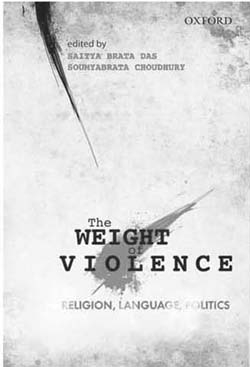The book under review, an edited volume by Saitya Brata Das and Soumyabrata Choudhury, comprising fifteen articles divided into two sections, is one of the important epistemic interventions concerning violence and its metaphysics. Besides addressing aforesaid questions in different ways, the book surprisingly and illuminatingly underlines the question of violence or violence theory in those thinkers/philosophers (Rene Girard, Sigmund Freud, Emmanuel Levinas, Jacques Derrida, Schelling, Deleuze, Nietzsche, Whitehead, Musil, Karl Marx and Walter Benjamin) who are otherwise known for their different impactful and consequential works. Identified realms of weight of violence are religion, language and politics.
Diverse contributors, as Saitya Brata Das point outs in the introduction, need to come together as he highlights the significance of cosmopolitan (scholarly-philosophical response world-wide) response to the phenomenon of violence which has threatened our existence itself. Moreover, he adds, dogmatic understanding concerning violence in the form of jargon or abstract are not required due to the massive presence and impact of technocratic-bureaucratic violence and modes of consumption under a neo-liberal economy. In other words, cliched definitions concerning the location of violence are not required. The issue, however, is to give unconditional response against conditional politics. The unconditional critique of violence must be followed by infinite vigilance over neutrality and rationality of the state apparatus which comes in the form of perfect democracy.
Gerard Bensussan in ‘On Violence: Mimesis, Death Instinct and Alterity’ suggests the incommensurability between violence and speech. Speechlessness thus devoid of responsibility (former causes latter and both are intrinsically linked) is a condition of a violent person. Violence begets mastery and ‘catastrophic obliteration of the victim’. Furthermore, he suggests that ‘this fear of the other that we invoke so often to talk about instances of “lack of civility”, of violence, of murder, is the fear felt when in front of the other, in front of the face, we experience fear from the knowledge that we could kill the other—it is thus a fear for the other, but a fear which starts from me commissioning the violence’ (p. 21). Andrea Potesta’s ‘The Experience of Silence: Derrida and the Language of Theology’ places the question of violence in Derrida centrally. Violence in the ultimate meaning (or closure) is countered through deconstruction in the form of infinite weakening of the meaning. In ‘Stupidity, Madness, and Male volence: Schelling, Deleuze, Flaubert, and the Problem of Violence’, Jason M. Wirth emphatically suggests that the ‘problem of metaphysics cannot be extricated from the more fundamental problem of the stupidity’ (p. 54). Aicha Livinia Messina’s ‘“No Eye Has Seen It”: The Renewal of the Human Condition in Marx and Levinas’ brings the justice question to the forefront while combining Marx and Levinas, i.e., combining materialism and eschatology. Thereafter, new order (messianism) or open order is unlocked by way of Marx in place of fixed or closed one. Maria Joao Cantinho, in ‘The Necessity for Clean Air and Space is Stronger Than Any Kind of Hatred: An Essay on the Concept of Violence and Religion in Walter Benjamin’, locates violence in Benjamin as a revolutionary gesture.
Continue reading this review

